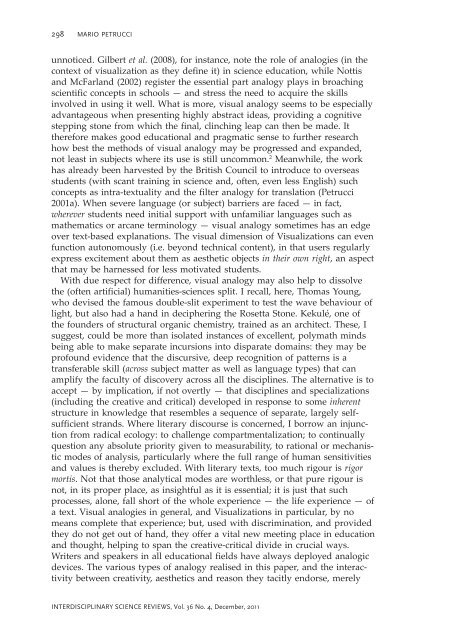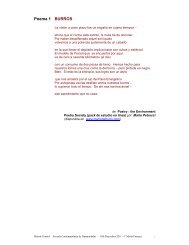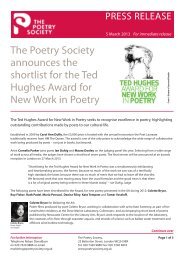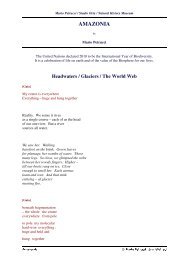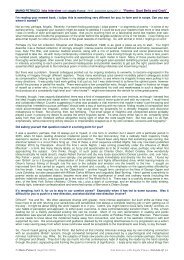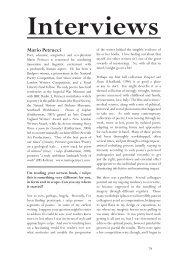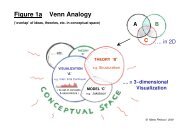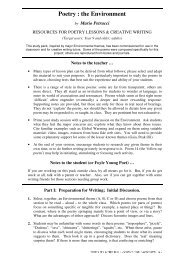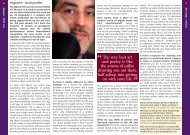Scientific Visualizations: Bridge-Building between ... - Mario Petrucci
Scientific Visualizations: Bridge-Building between ... - Mario Petrucci
Scientific Visualizations: Bridge-Building between ... - Mario Petrucci
You also want an ePaper? Increase the reach of your titles
YUMPU automatically turns print PDFs into web optimized ePapers that Google loves.
298 MARIO PETRUCCI<br />
unnoticed. Gilbert et al. (2008), for instance, note the role of analogies (in the<br />
context of visualization as they define it) in science education, while Nottis<br />
and McFarland (2002) register the essential part analogy plays in broaching<br />
scientific concepts in schools — and stress the need to acquire the skills<br />
involved in using it well. What is more, visual analogy seems to be especially<br />
advantageous when presenting highly abstract ideas, providing a cognitive<br />
stepping stone from which the final, clinching leap can then be made. It<br />
therefore makes good educational and pragmatic sense to further research<br />
how best the methods of visual analogy may be progressed and expanded,<br />
not least in subjects where its use is still uncommon. 2 Meanwhile, the work<br />
has already been harvested by the British Council to introduce to overseas<br />
students (with scant training in science and, often, even less English) such<br />
concepts as intra-textuality and the filter analogy for translation (<strong>Petrucci</strong><br />
2001a). When severe language (or subject) barriers are faced — in fact,<br />
wherever students need initial support with unfamiliar languages such as<br />
mathematics or arcane terminology — visual analogy sometimes has an edge<br />
over text-based explanations. The visual dimension of <strong>Visualizations</strong> can even<br />
function autonomously (i.e. beyond technical content), in that users regularly<br />
express excitement about them as aesthetic objects in their own right, an aspect<br />
that may be harnessed for less motivated students.<br />
With due respect for difference, visual analogy may also help to dissolve<br />
the (often artificial) humanities-sciences split. I recall, here, Thomas Young,<br />
who devised the famous double-slit experiment to test the wave behaviour of<br />
light, but also had a hand in deciphering the Rosetta Stone. Kekulé, one of<br />
the founders of structural organic chemistry, trained as an architect. These, I<br />
suggest, could be more than isolated instances of excellent, polymath minds<br />
being able to make separate incursions into disparate domains: they may be<br />
profound evidence that the discursive, deep recognition of patterns is a<br />
transferable skill (across subject matter as well as language types) that can<br />
amplify the faculty of discovery across all the disciplines. The alternative is to<br />
accept — by implication, if not overtly — that disciplines and specializations<br />
(including the creative and critical) developed in response to some inherent<br />
structure in knowledge that resembles a sequence of separate, largely selfsufficient<br />
strands. Where literary discourse is concerned, I borrow an injunction<br />
from radical ecology: to challenge compartmentalization; to continually<br />
question any absolute priority given to measurability, to rational or mechanistic<br />
modes of analysis, particularly where the full range of human sensitivities<br />
and values is thereby excluded. With literary texts, too much rigour is rigor<br />
mortis. Not that those analytical modes are worthless, or that pure rigour is<br />
not, in its proper place, as insightful as it is essential; it is just that such<br />
processes, alone, fall short of the whole experience — the life experience — of<br />
a text. Visual analogies in general, and <strong>Visualizations</strong> in particular, by no<br />
means complete that experience; but, used with discrimination, and provided<br />
they do not get out of hand, they offer a vital new meeting place in education<br />
and thought, helping to span the creative-critical divide in crucial ways.<br />
Writers and speakers in all educational fields have always deployed analogic<br />
devices. The various types of analogy realised in this paper, and the interactivity<br />
<strong>between</strong> creativity, aesthetics and reason they tacitly endorse, merely<br />
INTERDISCIPLINARY SCIENCE REVIEWS, Vol. 36 No. 4, December, 2011


